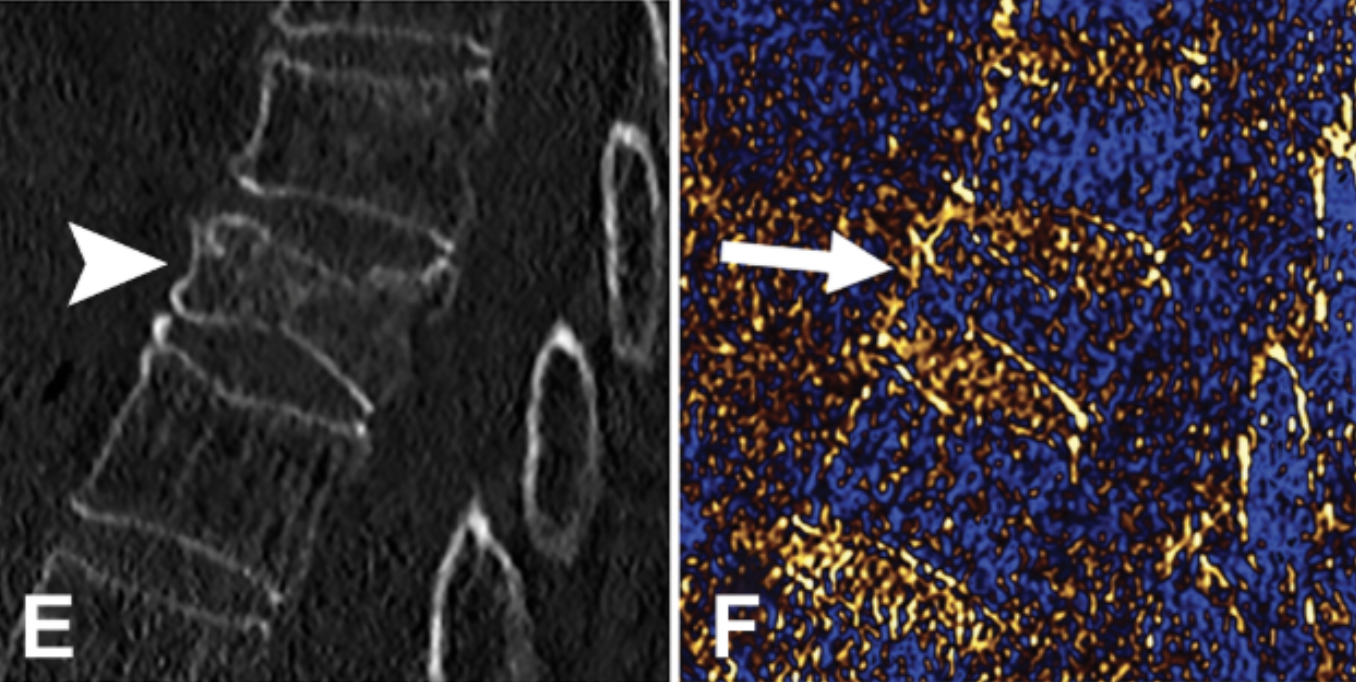What is Dual Energy CT?
Computed tomography derives images from attenuation of an X-ray beam as it passes through tissue. At typical diagnostic imaging X-ray photon energy levels, there are two main interactions which result in attenuation of the X-ray photon beam: the photoelectric effect, in which a photon is absorbed and an electron is ejected, and Compton scatter, in which a photon collides with a free electron and is deflected. The probability of a photoelectric effect interaction is proportional to the cube of the atomic number and inversely proportional to the cube of the energy level of the incident photon. The probability of a photoelectric effect interaction (and the associated attenuation associated with the effect) increases at levels where the photon energy matches the energy of the free electrons of the tissue, with the highest probability occurring at what is called the “K edge” of a material, where the photon energy is at the energy level of the electrons in the inner-most atomic shell (K shell) of the tissue.
Standard CT uses one polychromatic spectrum to generate images. Tissue composed of different materials can sometimes have same or similar CT numbers at a given energy level. Spectral CT addresses this by using spectra of varying energy levels, allowing for differentiation of materials which have different attenuation characteristics at these different energy levels. In clinical practice, this is done with two different energy spectra (hence the term “dual energy CT”) of low energy and high energy (often 80 kVp and 140 kVp).
There are multiple methods by which this can be accomplished: (1) dual-source, dual-energy, in which there are two X-ray sources producing two different spectra; (2) single-source, dual-energy, in which a single X-ray source either alternates between low- and high-energy production or is filtered into high- and low-energy components before entering the patient; and (3) detector-based, which uses filtering at the detector level to separate high-energy from low-energy data.
Following acquisition, image data can be reconstructed in several different ways, including:
Virtual monochromatic images: an image set is created from the predicted attenuation of a beam at a given energy level
Blended images: an image set is created by blending the low- and high-energy data at a specified ratio
Material decomposition algorithms can also be used to create additional images (for example, removing the contribution of iodine to produce virtual noncontrast images, or removing the contribution of calcium for bone removal).
Recommended Publications
Weinman JP, Mirsky DM, Jensen AM, Stence NV. Dual energy head CT to maintain image quality while reducing dose in pediatric patients. Clinical Imaging. 2019;55:83-88. doi:10.1016/j.clinimag.2019.02.005
Forghani R, Mukherji SK. Advanced dual-energy CT applications for the evaluation of the soft tissues of the neck. Clinical Radiology. 2018;73(1):70-80. doi:10.1016/j.crad.2017.04.002
Mocanu I, Van Wettere M, Absil J, Bruneau M, Lubicz B, Sadeghi N. Value of dual-energy CT angiography in patients with treated intracranial aneurysms. Neuroradiology. 2018;60(12):1287-1295. doi:10.1007/s00234-018-2090-5
D’Angelo T, Mazziotti S, Ascenti G, Wichmann JL. Miscellaneous and Emerging Applications of Dual-Energy Computed Tomography for the Evaluation of Pathologies in the Head and Neck. Neuroimaging Clinics of North America. 2017;27(3):469-482. doi:10.1016/j.nic.2017.04.008
Forghani R, Kelly HR, Curtin HD. Applications of Dual-Energy Computed Tomography for the Evaluation of Head and Neck Squamous Cell Carcinoma. Neuroimaging Clinics of North America. 2017;27(3):445-459. doi:10.1016/j.nic.2017.04.001
Forghani R, De Man B, Gupta R. Dual-Energy Computed Tomography: Physical Principles, Approaches to Scanning, Usage, and Implementation: Part 1. Neuroimaging Clinics of North America. 2017;27(3):371-384. doi:10.1016/j.nic.2017.03.002
Forghani R, De Man B, Gupta R. Dual-Energy Computed Tomography: Physical Principles, Approaches to Scanning, Usage, and Implementation: Part 2. Neuroimaging Clinics of North America. 2017;27(3):385-400. doi:10.1016/j.nic.2017.03.003
Hu R, Padole A, Gupta R. Dual-Energy Computed Tomographic Applications for Differentiation of Intracranial Hemorrhage, Calcium, and Iodine. Neuroimaging Clinics of North America. 2017;27(3):401-409. doi:10.1016/j.nic.2017.03.004
Kamalian S, Lev MH, Pomerantz SR. Dual-Energy Computed Tomography Angiography of the Head and Neck and Related Applications. Neuroimaging Clinics of North America. 2017;27(3):429-443. doi:10.1016/j.nic.2017.04.009
Komlosi P, Wintermark M. Dual Energy Computed Tomography Applications for the Evaluation of the Spine. Neuroimaging Clinics of North America. 2017;27(3):483-487. doi:10.1016/j.nic.2017.04.003
Kuno H, Sekiya K, Chapman MN, Sakai O. Miscellaneous and Emerging Applications of Dual-Energy Computed Tomography for the Evaluation of Intracranial Pathology. Neuroimaging Clinics of North America. 2017;27(3):411-427. doi:10.1016/j.nic.2017.03.005
Liao E, Srinivasan A. Applications of Dual-Energy Computed Tomography for Artifact Reduction in the Head, Neck, and Spine. Neuroimaging Clinics of North America. 2017;27(3):489-497. doi:10.1016/j.nic.2017.04.004
Pérez-Lara A, Forghani R. Dual-Energy Computed Tomography of the Neck: A Pictorial Review of Normal Anatomy, Variants, and Pathologic Entities Using Different Energy Reconstructions and Material Decomposition Maps. Neuroimaging Clinics of North America. 2017;27(3):499-522. doi:10.1016/j.nic.2017.04.005
Pérez-Lara A, Levental M, Rosenbloom L, Wing G, Forghani R. Routine Dual-Energy Computed Tomography Scanning of the Neck in Clinical Practice: A Single-Institution Experience. Neuroimaging Clinics of North America. 2017;27(3):523-531. doi:10.1016/j.nic.2017.04.006
Roele ED, Timmer VCML, Vaassen LAA, van Kroonenburgh AMJL, Postma AA. Dual-Energy CT in Head and Neck Imaging. Curr Radiol Rep. 2017;5(5). doi:10.1007/s40134-017-0213-0
Tawfik AM, Michael Bucher A, Vogl TJ. Dual-Energy Computed Tomography Applications for the Evaluation of Cervical Lymphadenopathy. Neuroimaging Clinics of North America. 2017;27(3):461-468. doi:10.1016/j.nic.2017.04.002
Patino M, Prochowski A, Agrawal MD, et al. Material Separation Using Dual-Energy CT: Current and Emerging Applications. RadioGraphics. 2016;36(4):1087-1105. doi:10.1148/rg.2016150220
Schick D, Pratap J. Radiation dose efficiency of dual-energy CT benchmarked against single-source, kilovoltage-optimized scans. Br J Radiol. 2016;89(1058). doi:10.1259/bjr.20150486
McCollough CH, Leng S, Yu L, Fletcher JG. Dual- and Multi-Energy CT: Principles, Technical Approaches, and Clinical Applications. Radiology. 2015;276(3):637-653. doi:10.1148/radiol.2015142631
Postma AA, Das M, Stadler AAR, Wildberger JE. Dual-Energy CT: What the Neuroradiologist Should Know. Curr Radiol Rep. 2015;3(5). doi:10.1007/s40134-015-0097-9
Postma AA, Hofman PAM, Stadler AAR, van Oostenbrugge RJ, Tijssen MPM, Wildberger JE. Dual-Energy CT of the Brain and Intracranial Vessels. American Journal of Roentgenology. 2012;199(5_supplement):S26-S33. doi:10.2214/AJR.12.9115

